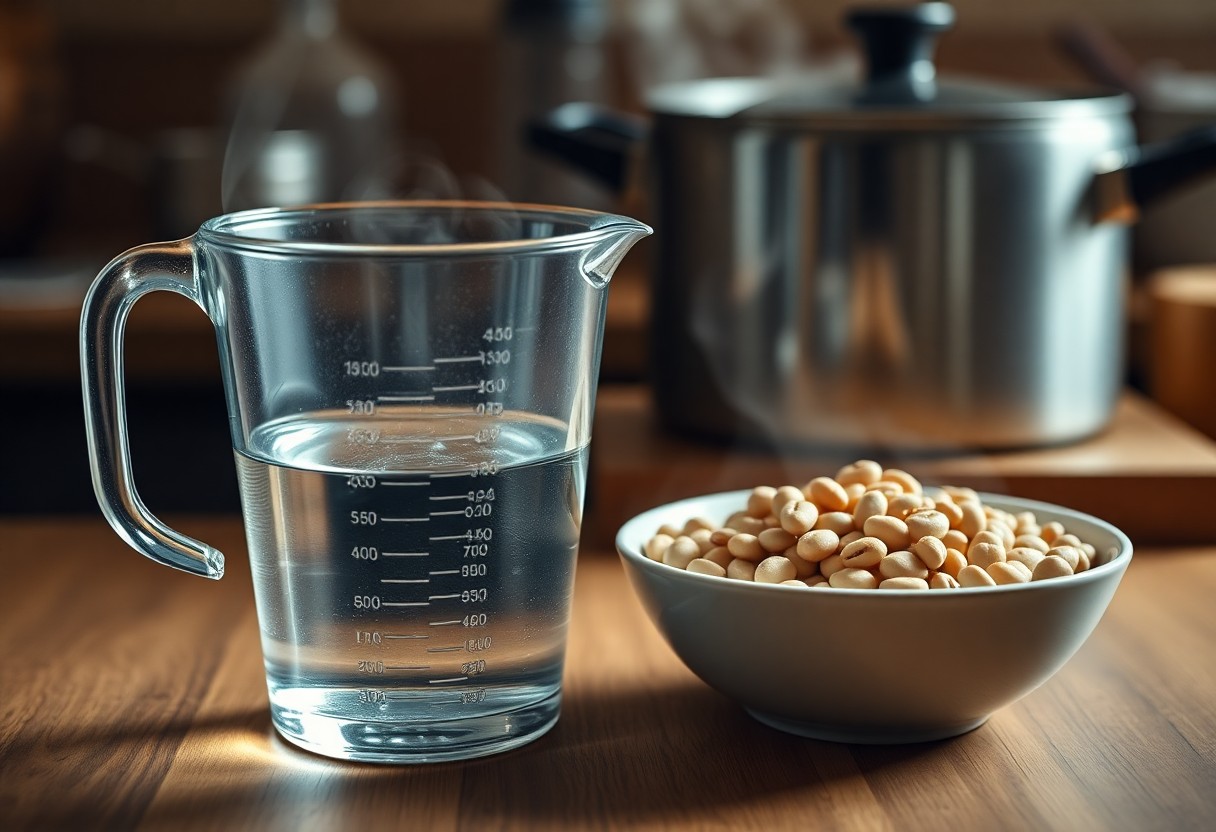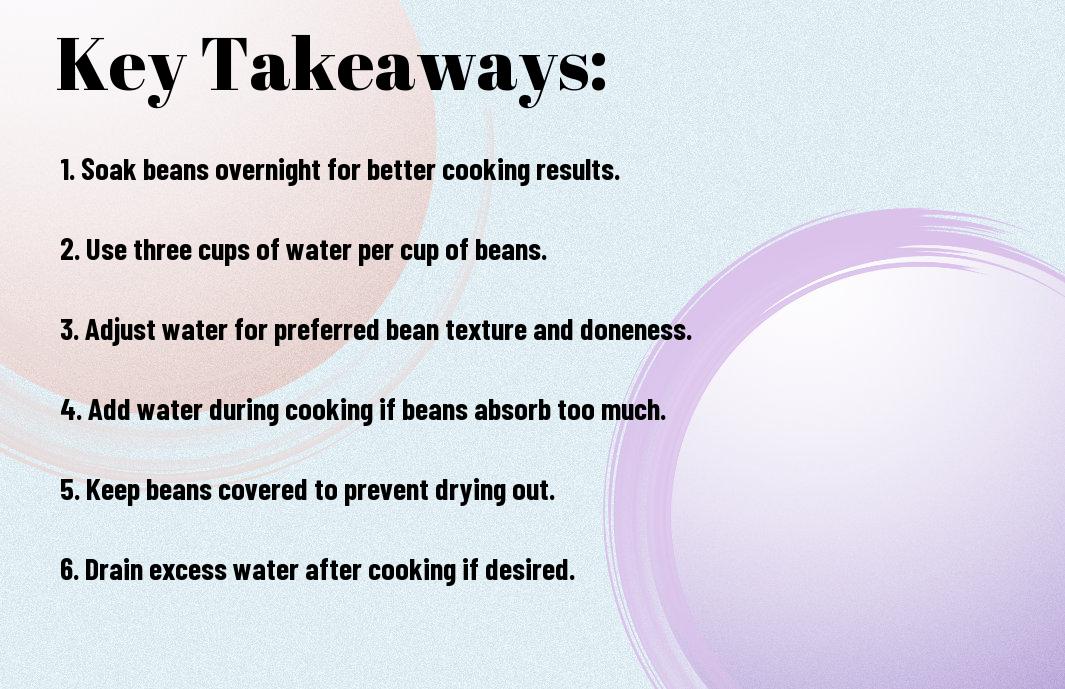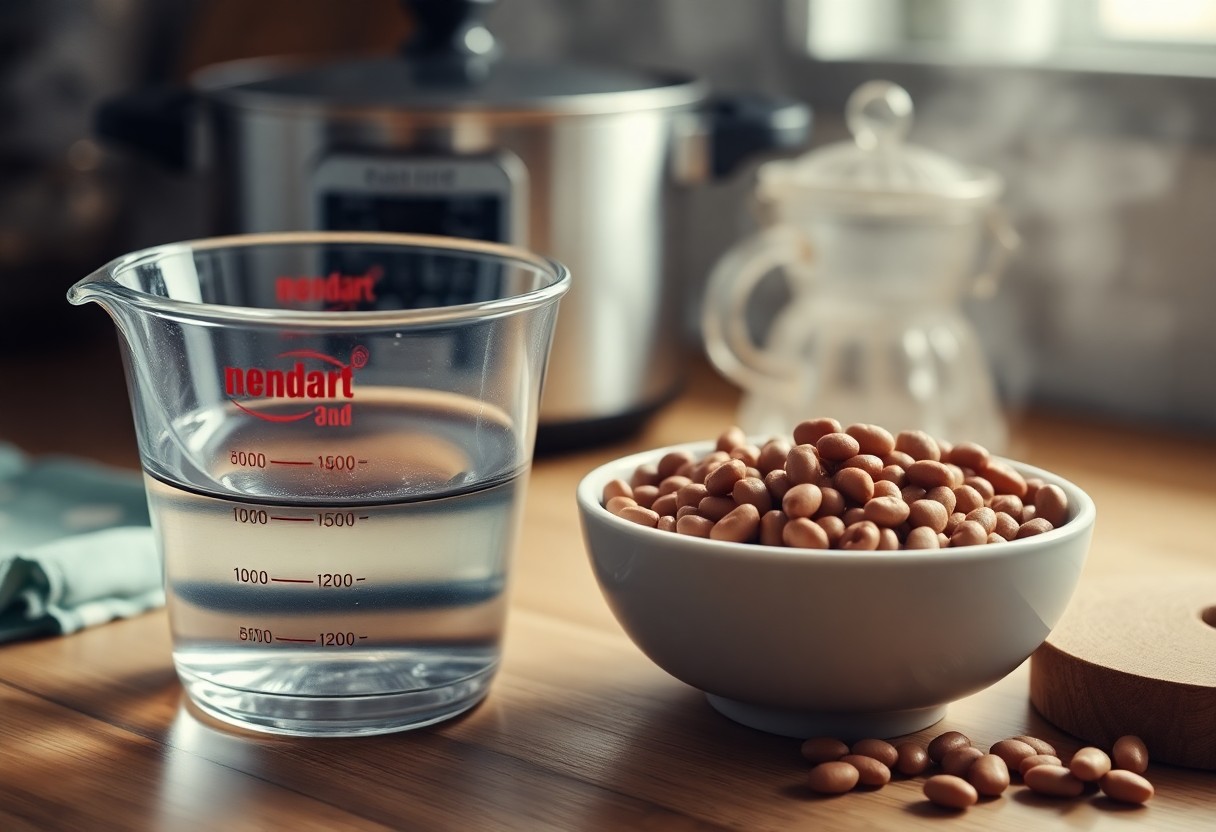Most home cooks might underestimate the importance of using the right amount of water when cooking beans. If you want your dish to turn out perfectly, it’s necessary to know that the standard ratio is 2 to 3 cups of water for every cup of dried beans. Using insufficient water can lead to undercooked beans, while excess water may result in a mushy texture. Whether you’re preparing a hearty chili or a delicious bean salad, understanding your water needs will enhance your cooking experience and ensure your beans reach their full potential.
Key Takeaways:
- For cooking a cup of dried beans, use approximately 3 cups of water to ensure proper hydration and cooking of the beans.
- Soaking beans prior to cooking can reduce the amount of water needed, as well as shorten the cooking time.
- Adjust water levels depending on your desired bean consistency; for softer beans, add slightly more water during cooking.

Understanding Beans
Your journey into the world of beans starts by recognizing their significance in various cuisines and diets. Beans are not only versatile ingredients that can enhance flavors and textures but also provide a wealth of nutritional benefits. From fiber to protein, beans are a powerhouse of imperative nutrients that contribute to your overall health. Knowing more about the types of beans and their unique characteristics will help you make informed choices in your cooking.
Types of Beans
Your culinary adventure with beans can begin by exploring the various types available, each with its distinct flavor profile and usage. Here are some popular varieties:
- Black Beans: Rich and earthy, great for soups and salads.
- Kidney Beans: Bold flavor and perfect for chili.
- Pinto Beans: Creamy texture, ideal for refried beans.
- Chickpeas: Nutty and versatile, used in salads and hummus.
- Lentils: Quick-cooking and nutritious for soups and stews.
After exploring these types, you’ll be better equipped to choose the right beans for your meals.
| Type of Bean | Cooking Time (Hours) |
| Black Beans | 2-3 |
| Kidney Beans | 2-3 |
| Pinto Beans | 2-3 |
| Chickpeas | 2-3 |
| Lentils | 0.5-1 |
Nutritional Benefits
Types of beans you incorporate into your diet can offer an amazing spectrum of health benefits that enhance your overall well-being. They are loaded with protein, making them an excellent meat alternative, and are also high in fiber, which promotes digestive health and aids in maintaining a healthy weight.
With their abundance of imperative vitamins and minerals, including iron and folate, beans provide significant health advantages. Eating beans regularly can help reduce the risk of heart disease and diabetes. Additionally, their low glycemic index helps in maintaining stable blood sugar levels. Incorporating beans into your meals not only enhances your diet but also supports long-term health.

Importance of Soaking
One of the best practices in cooking beans is soaking them before preparation. This step helps reduce cooking time, allowing the beans to soften and become tender more quickly. Additionally, soaking can enhance the digestibility of beans by leaching out some of the compounds that can cause gas and bloating. By incorporating soaking into your cooking routine, you can ensure a more satisfying and enjoyable meal.
Soaking vs. Not Soaking
The choice between soaking your beans or cooking them straight from dry can significantly impact your final dish. Soaked beans cook more evenly and require less time, while unsoaked beans can lead to a longer cooking process and often result in uneven texture. Many cooks prefer soaking for the benefits of better flavor absorption and increased tenderness, making it a method worth considering.
Duration of Soaking
To maximize the benefits of soaking, you should aim for a duration of anywhere between 4 to 12 hours. This range allows beans to hydrate adequately, preparing them for more even cooking. Shorter soaking times may not fully soften the beans, resulting in a tougher texture after cooking.

Consequently, you want to soak your beans for at least 8 hours, ideally overnight, for the best results. This soaking period not only enhances texture but also improves flavor and nutritional absorption. Keep in mind that if you’re short on time, a quick soak method—bringing beans to a boil for about 5 minutes, then letting them sit for an hour—can work, but it may not provide the same digestive benefits as a longer soak. Prioritize this step to ensure the best possible outcome for your meal.
Water Ratios
Once again, understanding the right water ratio is vital for cooking beans perfectly. Generally, the ideal ratio for most beans is about 3:1—three cups of water for every cup of dry beans. This allows for sufficient hydration and prevents the beans from drying out or sticking together. Adjustments may be necessary based on your cooking method or desired texture.
General Water Guidelines
For cooking beans, a consistent guideline is to start with a water ratio of approximately 3 cups of water per cup of beans. This ensures they cook evenly and absorb flavors. Always keep an eye on the cooking process, adding more water if needed. Here’s a quick reference:
| Cup of Beans | Cups of Water |
|---|---|
| 1 | 3 |
| 2 | 6 |
| 3 | 9 |
| 4 | 12 |
| 5 | 15 |
Variations for Different Bean Types
In fact, different types of beans might require distinct water quantities for optimal cooking. For example, you may need slightly more water for larger beans such as kidney beans, as they absorb more moisture. Here are some common beans and their recommended ratios:
| Bean Type | Water Ratio |
|---|---|
| Black Beans | 3:1 |
| Pinto Beans | 3:1 |
| Kidney Beans | 4:1 |
| Chickpeas | 4:1 |
| Lentils | 2:1 |
Perceiving the differences among bean types is vital; like kidney beans may need a more extended soaking period to achieve optimal tenderness, while lentils cook much faster. You can adjust your water ratios accordingly to achieve the best result based on the specific beans you are using.
- Kidney Beans: require 4 cups of water per cup
- Chickpeas: demand 4 cups for ideal softness
- Lentils: only need 2 cups
- Black Beans: prefer a 3:1 ratio
- Pinto Beans: also require a 3:1 ratio
In closing, the right water ratio can significantly affect your bean cooking results. Proper adjustments and knowledge about your specific bean type will lead to a satisfying meal. You may even discover new flavors when experimenting with varying amounts of water to enhance your dishes.
Cooking Methods
For cooking beans, there are several methods available that can yield delicious results, each requiring different amounts of water and time. You may choose between stovetop cooking, pressure cooking, or slow cooking, depending on your preferences and the time you have available.
Stovetop Cooking
An effective and traditional way to cook beans is on the stovetop. You’ll want to cover your soaked or unsoaked beans with water, typically using about 3 cups of water for every cup of beans. This method allows you to monitor the texture and adjust seasoning as you go.
Pressure Cooking
At times when you need a quick meal, pressure cooking comes to the rescue. This method significantly reduces cooking time; you can prepare beans in about 10-15 minutes. Using around 2-2.5 cups of water for every cup of beans is sufficient for optimal cooking.
Even though pressure cooking is fast, you should always ensure you follow your pressure cooker’s instructions for water levels and cooking times. If you undercook, beans can remain hard, while overcooking may result in mushiness. It’s important to allow the pressure to release naturally for better texture.
Slow Cooking
To achieve a rich, flavorful dish with tender beans, you can use a slow cooker. This method involves using about 4 cups of water for every cup of beans and allowing them to cook for 6-8 hours on low heat.
Plus, slow cooking allows the beans to absorb the flavors of any ingredients you add, creating a hearty meal. The gradual cooking process also helps to maintain the beans’ shape and texture, preventing them from turning into a mushy consistency. Always ensure your slow cooker is set to the proper heat to safely cook your beans through and through.
Common Mistakes
To ensure perfect beans, it’s vital to avoid some common mistakes. Many home cooks underestimate the importance of proper water measurements and cooking times, which can lead to less than ideal results. In this section, we’ll address using too little water and overcooking beans, so you can achieve bean perfection in your kitchen.
Using Too Little Water
Between adding insufficient water and cooking beans, inconsistency in texture and taste often arises. By not providing enough water, your beans may become dry and hard, resulting in a lack of flavor absorption and chewy texture. Always measure your water carefully to ensure that your beans cook evenly and develop the desired softness.
Overcooking Beans
An overcooked bean can lead to a mushy texture that detracts from their natural flavor. Knowing the right cooking time is important for achieving that perfect tenderness. When beans are overcooked, they lose their shape and become unappetizing. Additionally, overcooking can diminish their nutritional value, reducing the benefits you gain from this healthy food source. To avoid this, periodically check your beans as they cook and remove them from heat when they’re tender but still firm.
A good practice is to start checking your beans about 10-15 minutes before the recommended cooking time. This way, you can ensure that you catch them at the perfect moment. Using a timer can help, but be guided by the texture. If you find they’re undercooked, you can always return them to the heat for a little while longer. Your beans should have a pleasant bite and hold their shape, enhancing your meals with both flavor and nutrition.
Adjusting Water for Flavor
Not only is the quantity of water important for cooking beans, but the flavor can also be adjusted with various ingredients. You can enhance your dish by adding a bit more liquid to incorporate spices or herbs, which will deeply infuse your beans with rich flavors. Experimenting with the right amount can transform your meal, turning a simple dish into a delicious centerpiece.
Infusing Broth or Seasonings
Behind the basic water principles, you can elevate your beans by using broth or seasoning to cook them. Swapping plain water for vegetable, chicken, or beef broth adds an extra layer of flavor that will enhance the overall taste. Additionally, incorporating herbs and spices directly into the cooking liquid can further enrich your beans, delivering a more satisfying and complex flavor profile.
Impact on Texture and Taste
Texture plays a pivotal role in how you perceive flavor when enjoying your beans. When you adjust water levels, you also affect how well your beans absorb flavors during cooking. If there’s too much water, your beans may end up waterlogged and mushy, diluting their natural taste. Conversely, using less water can create a denser and more concentrated flavor but may lead to undercooked beans. It’s vital to strike the right balance for optimal texture and taste that enhances your dish.
To wrap up
With these considerations, you can effectively determine the amount of water needed to cook a cup of beans. Typically, using three cups of water per cup of dried beans will yield a well-cooked texture while allowing for absorption. However, factors like the type of beans, cooking method, and personal preference can influence your specific needs. Make sure to adjust based on your cooking experience and desired outcome for the best results.
FAQ
Q: How much water is needed to cook one cup of dry beans?
A: For one cup of dry beans, you typically need about 3 cups of water for cooking. This ratio can vary slightly depending on the type of beans and the cooking method used.
Q: Should I soak beans before cooking, and how does that affect the water needed?
A: Soaking beans prior to cooking can reduce the cooking time and may allow you to use slightly less water. If you soak the beans, you can use approximately 2 to 2.5 cups of water for each cup of soaked beans.
Q: Does the type of beans affect the water-to-bean ratio?
A: Yes, different types of beans may require varying amounts of water. For example, smaller beans, like lentils, often need less water (about 2 to 2.5 cups) than larger beans, such as kidney or black beans, which may require 3 cups or more.
Q: What cooking methods impact the amount of water needed for beans?
A: Cooking methods such as stovetop boiling, slow cooking, or pressure cooking can influence the water required. Generally, using a pressure cooker may need less water compared to boiling on the stovetop due to reduced evaporation.
Q: How do I know when the beans have absorbed enough water and are fully cooked?
A: Properly cooked beans should be tender and easily mashable. You can check for doneness by tasting a bean or mashing it. If they are still hard, they may require more water and additional cooking time.
